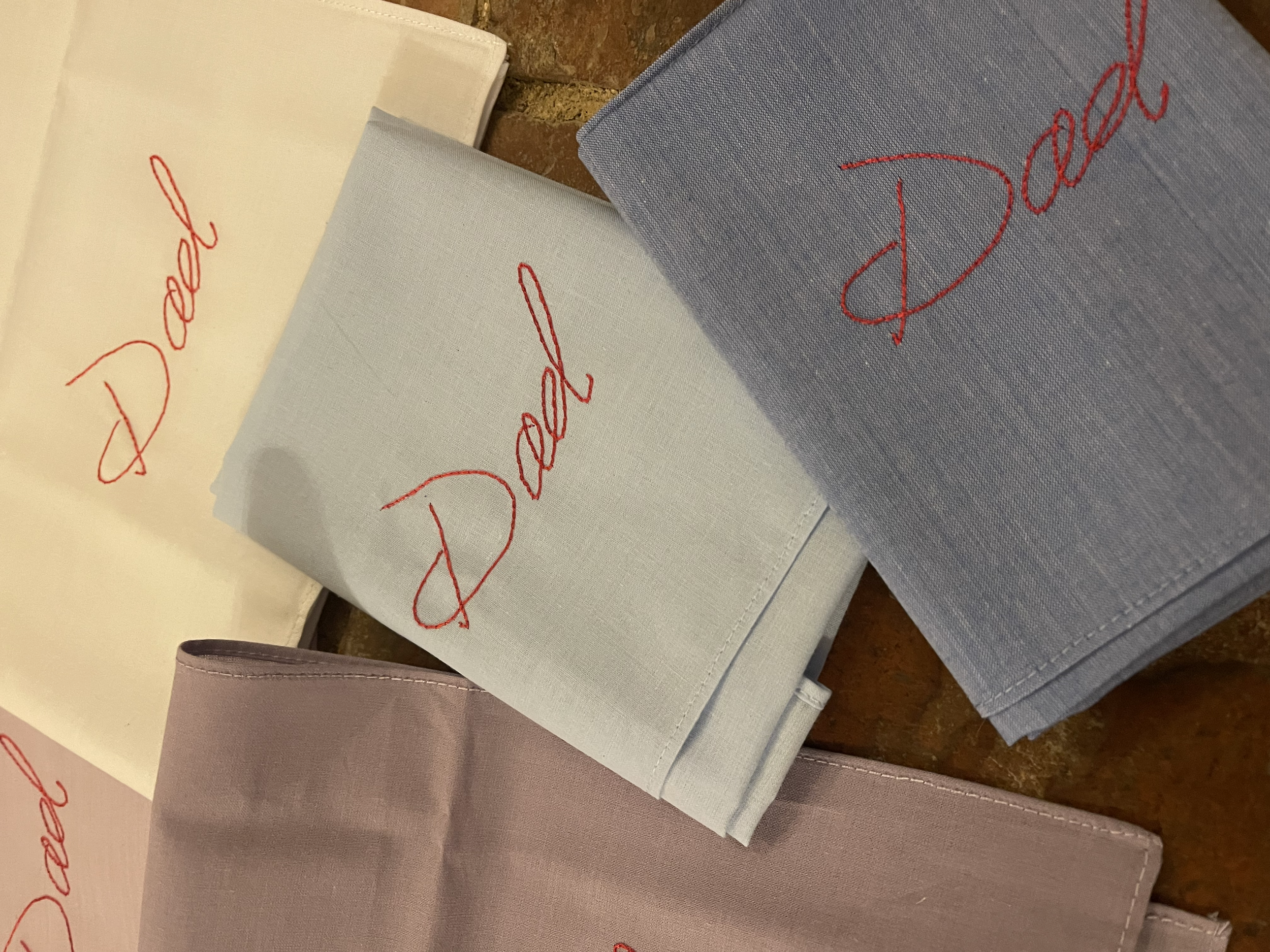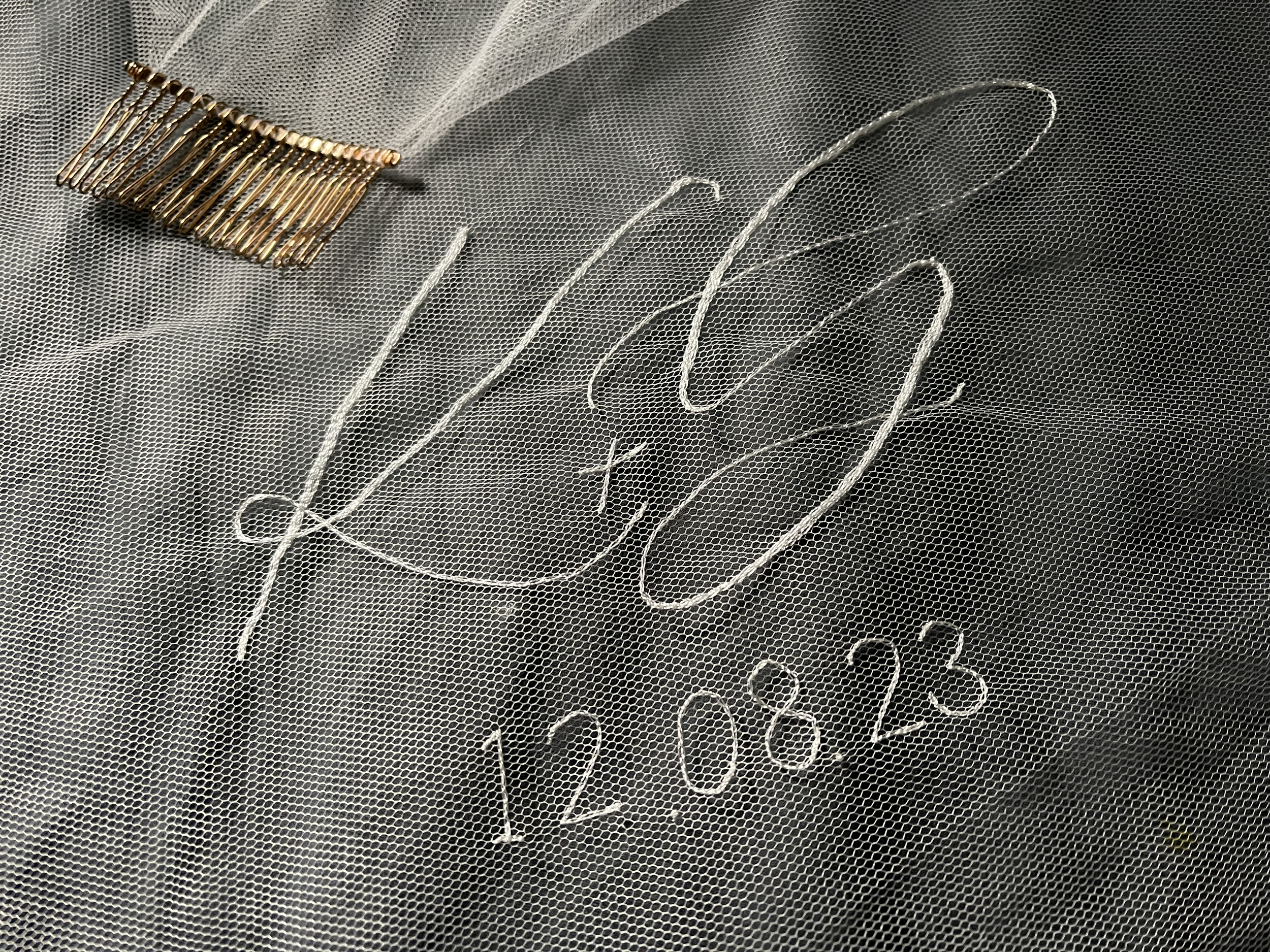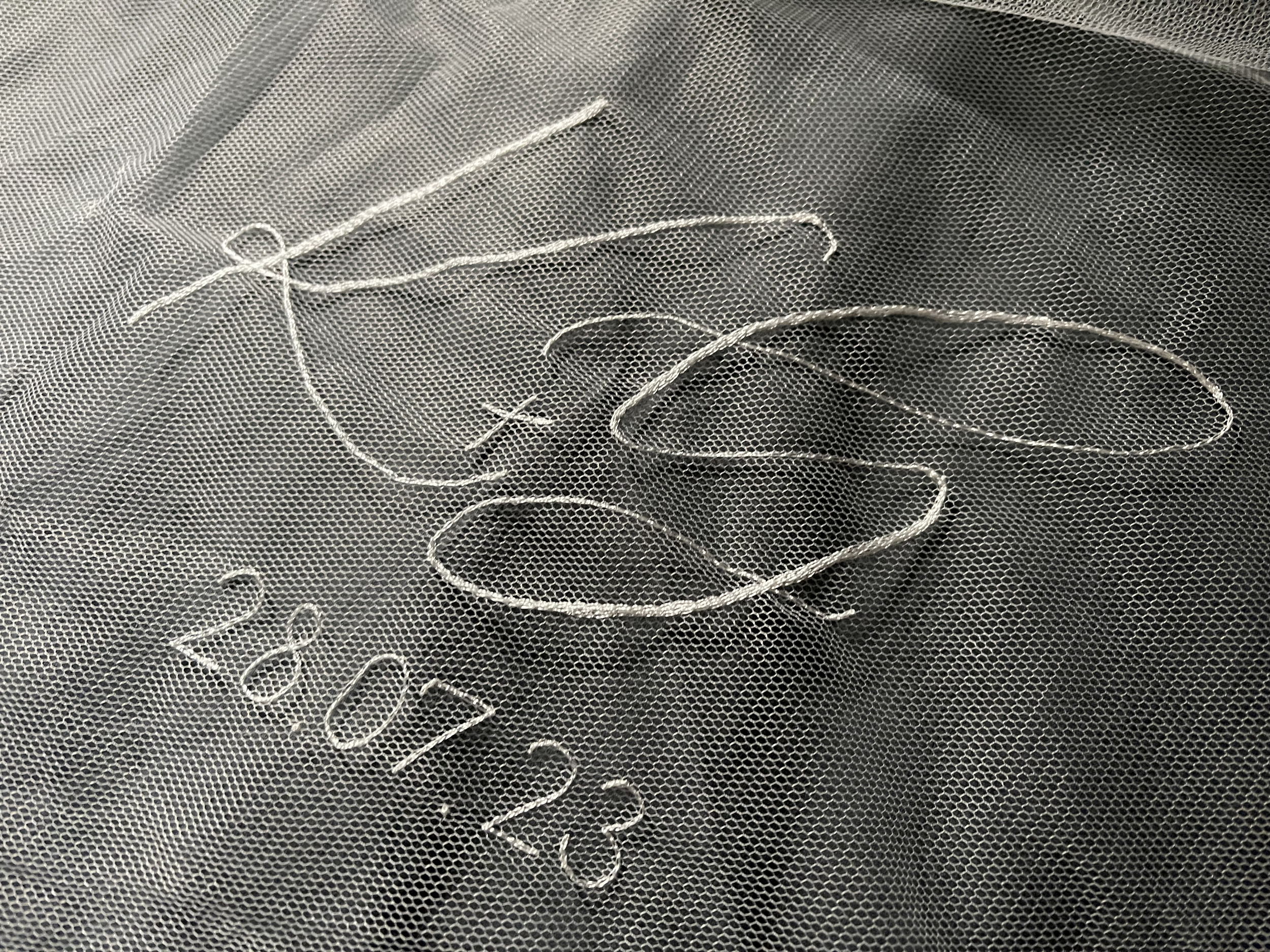Materials and Fabric:
What type of fabric will be used for the veil?
Standard fabric for veils is called Tulle. This fabric is a fine netting that hangs from the top of the head. This fabric, being very fine, doesn't hide your gorgeous wedding hairstyle.
Do you offer different fabric options such as silk, tulle, or lace?
Of course. We can add lace, beads, monograms, appliquéd fabrics. If there’s a design or style that you love let us know!
Are there specific colour choices available for the fabric and threads?
There are some limitations for colours of tulle, though thread colours are never ending. If there is a certain shade that you are looking for, request a shade card.
How does the choice of fabric affect the overall look and feel of the veil?
Yes, there are different manufactures of tulle, all with different feels. Some ‘crispier’ tulles are stiffer creating a more bold affect. And other more soft create a romantic feel to the back of your dress.
Monograms can be added to any tulles!
Design and Style:
What design elements can be incorporated into the veil?
Names, dates, places, animals, plants, coordinates, symbols…
Do you have a portfolio or examples of previous hand-embroidered veils?
Yes! Look through our Real Brides photos
Can the design be customised to reflect personal motifs or themes?
Of course, my most commonly made monograms include simple line art as this suits the durability of the fabric and the general wedding theme. However, if you would like something more filled (lace like, or appliqué like) this is possible.
Are there different styles or lengths of veils available for embroidery?
You are welcome to purchase your wedding veil through me. Else if you have found one that you love, I can add to your own veil!
Stitching Your Story: How Embroidery Names Add a Personal Touch to Your Wardrobe
In today's world of mass-produced clothing, it's easy to feel like your wardrobe lacks personality and individuality. That's where embroidering names come in. Adding your name, initials, or even a meaningful word to your clothing through the art of embroidery can bring a personal touch to your wardrobe that sets you apart from the crowd. Not only does it add a unique element to your wedding, but it also allows you to tell your story. From monogrammed veils to customized ribbons, embroidered names are a timeless and classic way to elevate your wedding wear. So, let's dive in and discover how stitching your story can add a personal touch to your day.
Choosing the right font
The font seen in most to all of these images is a custom made font. Most brides choose a classic calligraphy style for their monogram, but this doesn’t work for everyone. There are millions of fonts and all of them can be embroidered, send an image of the font you’d like used.
Handwriting is a gorgeous way of adding in a loved one to your accessories
Can I do it myself?
Yes it is possible to stitch it yourself. But I cannot stress enough how fragile tulle is. I have worked with this fabric for over 5 years and have used it on both machines and by hand, and know how delicate it is. My degree in hand embroidery taught me essential ways to embroider without damaging the fabric. If you are to try it yourself, practice on spare fabric first!
Professional embroidery services
Embroidery is a precise art that has many forms. Specific embroidery machines are programmed with set fonts and frequently require calibration. With how delicate the fabric is machines have a tendency to tare the fabric. Hand embroidery in this instance is the safest option. When requesting embroidery services, ask for close up images of previous work to ensure quality and attention to detail has been assured.
A Guide to Finding Your Perfect Wedding Accessory
For many brides, the perfect wedding dress is often the centerpiece of their big day, but it's the accessories that complete the look. One accessory that can make a dramatic impact on your wedding day is the veil. Bespoke veils, in particular, can add a unique and personalized touch to your bridal ensemble. However, finding the perfect bespoke veil can be overwhelming. With so many styles, lengths, and fabrics to choose from, it's easy to get lost in the sea of options. But fear not! In this guide, we'll take you on a journey to unveil the beauty of bespoke veils and help you find your perfect wedding accessory. From understanding the different types of veils to selecting the right length and embellishments, we've got you covered. So sit back, relax, and get ready to discover the world of bespoke veils.
What length should my veil be?
There is not a single answer for this question, as it is based so much so on preference. With current more decorative dress styles, having a simpler veil is the most compatible choice. Traditionally veils are longer than the dress to create a layered affect behind you. This creates the perfect space for a custom monogram.
Things to consider:
The length of the aisle - for longer aisles a long veil suits perfectly as it has the space to be shown off.
Transportation - planning to arrive in/on something unique? having a shorter veil may prove more helpful and less tangled in moving around.
Hair style - many hairdressers insist on having a veil with loops on to “hide” the attachment. But having a veil on a comb allows for easy removal for dancing and a more relaxed evening.
Blusher or not to blusher?
The traditional uses of a blusher are included in the “giving away” part of older ceremonies. As most weddings no longer follow the same purpose, the use of a blusher is for a tiered affect behind the head of the bride and stay behind the head rather then in-front.
White, Ivory, Cream or Nude?
Most modern veils are made of a fabric called tulle. This fabric is a twisted single thread making either hexagons or diamond shapes. There is so little thread in the composition of the fabric, that the shade doesn’t have to be exact. But as a rule of thumb - ‘white’ is paper white and so unless your dress is this shade it is best to choose ivory.
Types of Tulle
Tulle comes in a variety of compositions. Traditionally tulle is made out of pure silk, which is costly as a luxury. Modern veils are a combination of nylons. The tulles can be softer and more floppy, stiff or somewhere in between.
For embroidery purposes diamond tulle, also known as Italian tulle, is the easiest to stitch onto as its diamond shape allows for the embroidery to be anchored more frequently.
Embellishments
How much is too much?
Historically veils have been plain a simple with no decoration. But with sleek and modern themes becoming popular, having a decorative veil with a plain dress is not only more cost affective but allows for more timeless wedding photos.
Matching my dress - whether it is lace, writing or beads and pearls. There are so many options to match your dress and veil.
Stand alone pieces - monograms like initials and dates are a perfect personal touch that match with all wedding themes!
Hand Embroidery Commissions
Pricing different commissions is a challenge. The prices you see are based solely on the hours it takes me to embroider your requests. If you are looking for something specific, but want it set within a budget, please add this into your enquiry.
In general, I would estimate that if the monogram you are looking for fits within the size of an A4 page then the price will sit around £70 + shipping. If you are looking for something very small or simple then this would be less.
My turnaround times for this size of commission is approximately 2 weeks, however during busy periods, or for large designs this can be longer.
My aim is to make personalisation affordable to all as it’s so important to me that everyone’s wedding day should be the best it can be.
Please contact me with your enquiries.















